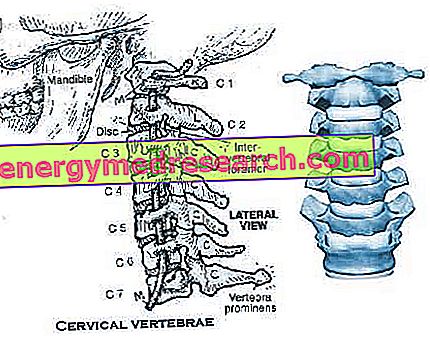The cervical tract is the most mobile part of the spine and in some respects even the most delicate. In addition to supporting, stabilizing and making the skull mobile, in fact, it protects the structures that pass through it, such as the spinal cord, the nerve roots and the vertebral artery. Suffice it to say that serious injuries of this trait involve tetraplegia (paralysis of the four limbs) and, if the lesion occurs at the level of C1-C2, the death of the individual.
The cervical spine has a curvature of about 36 ° with anterior convexity - called lordosis - which varies in relation to the modifications of the other spinal curves and is generally more marked in elderly people.
The cervical spine consists of seven vertebrae, distinguishable - on the basis of some anatomical peculiarities - in an upper region (C1-C2) and in a lower region (C3-C7); for this reason the first part of the spine is didactically divided into the upper cervical spine and the lower cervical spine.

Upper cervical spine: atlas and axis
The first two cervical vertebrae, the atlas and the axis, are very different from the other vertebrae in the column. The atlas is a bony ring consisting of an anterior arch, a posterior arch and two lateral masses (it is devoid of vertebral body and spinous process). Each of these two bony massifs has an upper and lower articular facet, which articulate with the occipital condyles and with the axis respectively. The latter consists of a vertebral body and a bifid spinous process such as the underlying vertebrae, from which it is different for the large apophysis of the bone that starts from the anterior part of its vertebral body (odontoid, odontoid process, or epistemic tooth) ; this bone segment, which is nothing more than the residue of the atlas body, is articulated with the front arch of the atlas itself, constituting the axis around which C1 can turn in the rotational movements of the head.

| Atlas, upper vision; zoom and credits | Epistropheus, upper vision; zoom and credits |
The atlas owes its name to the eponymous mythological character who was believed to carry the weight of the world on his shoulders, just as the vertebra does with the "globe" of the head.
The atlanto occipital articulation allows moderate movements of lateral flexion, 10 degrees of flexion and 25 of extension; a few degrees in the same directions are also allowed by the articular relationships between C1 and C2. On the other hand, however, the atlas and the axis provide the main contribution to the rotation of the cervical spine, which they sustain for 45 ° in both directions.

The intervertebral disc is not interposed between C1 and C2 and excessive movement is limited by the ligaments and joint capsule.
The mobility of the upper cervical spine is essential to maintain the correct alignment of the sense organs located in the head (sight and hearing).
The muscles that participate in the movement of the upper segment of the cervical spine are shown in the following table.
| Anterior region muscles | Posterior region muscles |
| Muscles above and below the iodine, anterior rectum and the long muscle of the neck. | Small and large straight lines of the head, upper and lower obliques and lateral rectum. |
Lower cervical spine
The lower cervical spine consists of the remaining 5 vertebrae (C3-C7), which have a greater degree of similarity in shape and function. The anatomical peculiarities that characterize them:
vertebral body of reduced size compared to the underlying vertebrae;
spinal bifid (bifurcated) processes from C3 to C6;
presence in C7 ( prominent vertebra ) of a particularly long spinous process, easily palpable on clinical examination in many individuals (see figure);
presence of creniform apophyses, located in the superior and inferior lateral part of the vertebral bodies, which articulate themselves to form the one-vertebral joints (or of Luschka) through two cartilaginous facets.
Compared to the upper cervical tract, this region of the column is no longer specialized in rotation, but in anterior, posterior (extension) and lateral flexion. The latter is mainly entrusted to the upper section (C3-C4 and C4-C5), while the decrease - equal to about 10 degrees per segment - is maximum at the level of C4-C5 and C5-C6.

| Anterior region muscles | Posterior region muscles |
| Long muscle of the neck, small anterior rectum, lateral rectum of the head; more laterally the scalenes and the sternocleidomastoid. | Intrinsic (deep) muscles: spiny transverse or multifidus, inter-transversal and epispinose; above the splenium, half-spinal of the head and neck, transversus of the neck, angular of the scapula, long dorsal; Superficial muscles: trapezius. |



